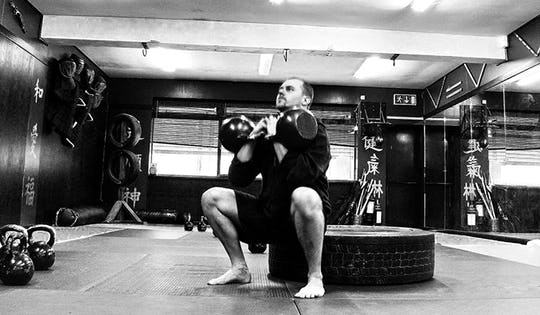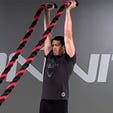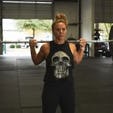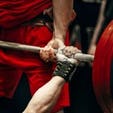“Strong punches come from the shoulders,” says the old school boxing coach, “Hit the deck and give me 50! “Sound familiar? I’ve seen this scene play out in martial arts clubs around the world and I’ve been in quite a few. Over the years I’ve studied a variety of fighting styles in a variety of countries. In my own gym we have a collection of fantastic coaches, each one an expert in their field having been, or having produced, champion fighters.
But it seems to be a common theme, especially with older coaches, that weight training will steal your speed, leave you slow and muscle-bound. All you need to do is a few push ups, a few sit ups, run, and skip. Unfortunately, this advice is flawed.
Why Weight Training is Necessary for MMA
Punches do not start at the shoulder, they come from the ground. Part of my training came from the internal martial arts and chi gung. In these circles it was common to hear the advice to “borrow force from the earth,” which is a poetic way of saying that a strike starts by pressing the foot into the floor. Newton’s 3rd law states that for every action there is an equal and opposite reaction: if I press down into the earth, the earth presses back on me.
If I “borrow” this force, load it into the Achilles tendon which springs back extending the ankle, the force continues up the leg extending the knee and hip, it then hits the waist turning it and whipping the shoulder forward; this propels the arm out and into the other geezers mush sending him to sleep.The push up, while a great exercise, focuses on the very end of the action. For the rest of the muscles in the sequence, it is a good idea to ignore the coach and hit the weight room.
Of course many students have come to this conclusion on their own. They strut onto the mat with puffed up chests and bulging arms but half an hour later they are shot, tired, and gasping for breath. So it seems the coach may be right, these guys train diligently with weights, yet they are slow, there’s no power in their punches, and they fatigue quickly: exactly the fate the coach said their muscle bound hides would face.
Strength Training with Kettlebells for MMA
The coach’s opinion on weight training is usually based on his experience with bodybuilders. The big lads coming in training with their shapely pecs most likely train with a body part split, each workout dedicated to a specific part of their physique. But bodybuilding is a purely aesthetic endeavor; it builds a pleasing appearance but has little, if any, carryover to athletic performance. Strength training is an entirely different animal.
A proper strength training program bears no resemblance to a bodybuilding program. Strength training for a fighter must revolve around improving the performance in the ring, anything that takes away from this must be dropped without a second thought.
Working with my fighters, I soon realized that the less is more approach is definitely the way forward as they spend so much time drilling, hitting bags, and sparring that they don’t have the time or energy to spend in the gym. This has lead to the development of some very efficient training methods which have taken many average fighters and turned them into exceptional ones.
Earlier in the article we talked about borrowing force from the ground and how the body extends up and out into a knockout punch. The most efficient exercises that develop this skill are the ones that call for hip extensions, like the squat, the deadlift and their variations. If you’re a grappler, don’t worry about the squat, the deadlift and its brothers, high pulls and power cleans are the lifts for you.
On the other hand, a boxer will get a lot of benefit out of the front squat. Why front squat and not back squat? In my experience, while the back squat is the more manly lift, in terms of athletic carry over, the front squat trumps it. There’s less load on the back and more load on the abs (even more so if you use kettlebells) and there’s a greater need for mobility in the ankle, hip and thoracic as any forward lean will cause the bar to fall forwards.
Heavy Kettlebell Training for MMA Power
To avoid the bodybuilder trap of becoming slow, tight and inflexible, it is vital to work through a full range of motion keeping the reps low, the rest periods long and lifts as explosive as possible. There’s no need to do more than 5 reps and rest periods should be at least 2 minutes.
Ok, I know this won’t do much for your stamina, we’ll look at that in a minute. First we’ll deal with generating power. Lift a heavy weight as fast as humanly possible then rest as long as it takes to be able to do it again with good form.
Training with higher reps and shorter rest periods is less effective for building brute strength and power but more effective for adding mass to the body, something you need to be careful of if you compete in a weight class.
Every now and again switch to single leg work as it has the greatest athletic carry over; think about it, you push off from one leg when you launch that punch, you stabilize through one leg when you perform that hip throw.
Split squats, especially with the rear foot elevated, are the ultimate leg strengthening drill in my opinion, but also add in single leg deadlifts and pistol squats for diversity. I tend to keep single leg work for more advanced athletes and even then they only do it once per week. I find the standard squat and deadlift are better for developing full body explosive power.
Kettlebell Power Workouts for MMA Training
Again we find old school coaches talking about running, skipping, and running again. But is there a better way? Of course there is: circuit training. Even better again are what I call power circuits, a form of circuit training that I began using as I got more and more bored with standard strength training routines.
Those long rest periods seemed so inefficient, yet so necessary. I started asking myself if there was a better way and, almost by accident, I stumbled across the power circuit format and both my strength and endurance improved immediately.
Power circuits are built around your main lift for that day, usually a front squat or a deadlift. You then add 1 to 3 other drills, not so many that you’ll be too exhausted to improve the main lift, but enough that the whole body is covered in a variety of ways.
The other drills are usually upper body and core focused but on occasion it is nice to use contrast exercises (alternate between deadlifts and heavy kettlebell swings and see how you enjoy walking the next day!)
When choosing the other exercises to put into these circuits, I find it beneficial to see what kind of movements the fighters are performing in their regular training. Our kickboxing coach loves planks, press ups, and leg raises, so I stay away from them to avoid over use in these patterns.The BJJ coach is all about forward flexion of the spine, which is understandable given the art, so I give the guys drills that counter these movements and keep the body balanced.
For upper body pushing, rather than standard push ups, I use Hindu and divebomber push ups as they both hit the shoulder in a more holistic manner while also extending the spine.I also teach them the one arm clean and jerk with a kettlebell, quite possibly the finest lift any fighter can employ in their training as it teaches power generation from the ground up.
7 Kettllebell Power Workouts for MMA Training
Power Workoutt 1:
A1: Deadlift x 5, 4, 3, 2, 1 reps (increasing weight each round as the reps drop)
A2: 1-Arm Clean & Jerk x 8-12 reps (each side)
A3: Sledgehammer Slams x 30 seconds
Rest approx 1 minute between rounds.
This works the entire body through a variety of movements and rep ranges, developing strength and stability through the core, shoulder endurance, and teaches the body to generate huge amount of power from the ground up with both the heavy deadlifts and repetition clean & jerk. The whole thing can be done in around 20 minutes, but take longer rests to develop strength. Closer to a fight reduce the rests to emphasize conditioning.
Here are a few other circuits I use with my fighters:
Power Workout 2:
A1. Deadlift x 1-3
reps
A2. Standing Russian twist x 5 reps(each side)
A3.
Divebomber push-up x 8-12 reps
Increase weight on the deadlift each round, perform 4-6 rounds. This is very popular with the grapplers.
Power Workout 3:
A1. Deadlift x 1-3
reps
A2. Double kettlebell swing x 8-12 reps
A3.
Sprint (whatever distance is appropriate to either your sport or fitness)
Increase weight on the deadlift each round and go heavy on the swings. Have fun walking the day after this one!
Power Workout 4:
A1. Back squat x 5 reps
A2.
Dips x Max reps
A3. Chins x Max reps
This is a very basic circuit that I use with non-combat athletes and less experienced lifters.
Essentially we are doing a squat workout, after each set they move over to the pull up station and bang out as many reps as possible (with perfect form) and come back to the squat rack. It forces newbies to take a good long rest between squat sets, especially if they’re still mastering technique.
Power Workout 5:
A1. Front Squat x 3 reps (increase weight each round)
A2.
Dips x max
reps
A3. Heavy kettlebell snatch x 3-5 reps(each side)
A4.
Chins x max
reps
For some reason this has become my most popular circuit although 4-6 rounds of this is enough for most. The MMA boys seem to especially love it.
Power Workout 6:
A1.Pistol Squat x 5 reps each side
A2. Double KB Clean & Press x 5
reps
A3. Double KB Snatch x 5 reps
This obviously isn’t for beginners but it is one of my personal favorites. Pistol squats challenge the body in so many ways, strength, mobility, balance, the list goes on. Team these up with the sheer power needed to explosively clean, press and snatch a heavy pair of bells, you’ll be a tired unit in no time!
As stated these workouts can be done in as little as half an hour, so are perfectly suited to slot into the routine of even the busiest combat athlete. If they are up for further work, simply get them to sprint, I find the following usually keeps them quiet:
Power Workout 7:
A1.Burpees x 5 reps
A2.
Sprint x 15 meters
4-6 rounds or AMRAP x 15 minutes
Depending on the athlete’s level and needs 2 or 3 of these circuits per week will work wonders for their strength and conditioning. If they still want to go out do hundreds of push ups and run a 10km every morning, ask them to give you 4 weeks of this training and see how they feel. Chances are they’ll be doing push ups in their martial training anyhow. Their road work should be kept to a single long steady jog with chilled out tunes playing on the iPod to help them recover and relax the head.
By the end of the month, their ability keep dropping bombs into the later rounds will have significantly improved and they’ll never doubt you again.


)





